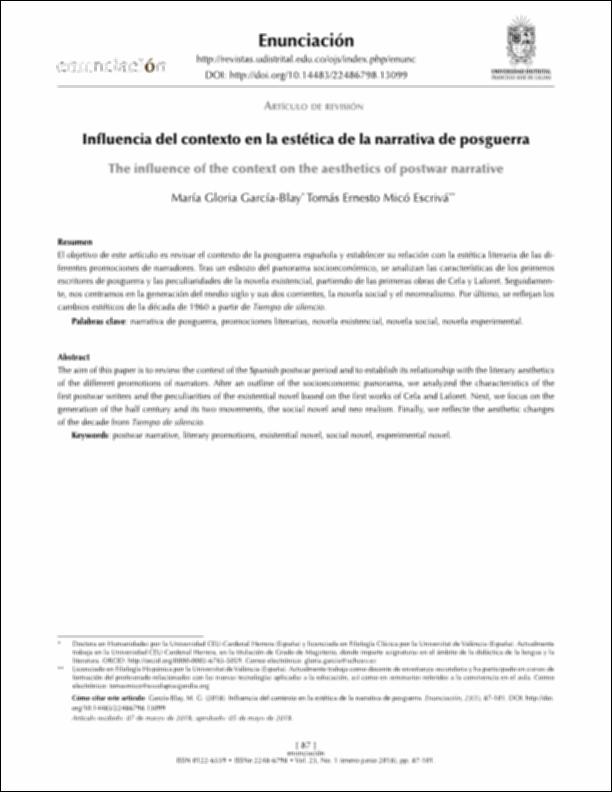Por favor, use este identificador para citar o enlazar este ítem:
http://hdl.handle.net/10637/9988Influencia del contexto en la estética de la narrativa de posguerra
| Título : | Influencia del contexto en la estética de la narrativa de posguerra |
| Otros títulos: | The influence of the context on the aesthetics of postwar narrative |
| Autor : | García Blay, María Gloria Micó Escrivá, Tomás Ernesto |
| Materias: | Experimental fiction - 1939-1969 - Spain.; Realism in literature - 1939-1969 - Spain.; Literatura - Estética - 1939-1969 - España.; Literature - Aesthetics - 1939-1969 - Spain.; Escritores - 1939-1969 - España.; Literatura española - 1939-1969.; Authors - 1939-1969 - Spain.; Novela experimental - 1939-1969 - España.; Spanish fiction - 1939-1969.; Spanish literature - 1939-1969.; Realismo (Literatura) - 1939-1969 - España.; Novela española - 1939-1969.; Spain - Social conditions - 1939-1969.; Spain - Economic conditions - 1939-1969.; España - Situación social - 1939-1969.; España - Situación económica - 1939-1969. |
| Editorial : | Universidad Distrital Francisco José de Caldas. |
| Citación : | García Blay, MG. y Micó Escrivá, TE. (2018). Influencia del contexto en la estética de la narrativa de posguerra = The influence of the context on the aesthetics of postwar narrative. Enunciación, vol. 23, n. 1, pp. 87-101. DOI: http://doi.org/10.14483/22486798.13099 |
| Resumen : | El objetivo de este artículo es revisar el contexto de la posguerra española y establecer su relación con la estética literaria de las diferentes promociones de narradores. Tras un esbozo del panorama socioeconómico, se analizan las características de los primeros escritores de posguerra y las peculiaridades de la novela existencial, partiendo de las primeras obras de Cela y Laforet. Seguidamente, nos centramos en la generación del medio siglo y sus dos corrientes, la novela social y el neorrealismo. Por último, se reflejan los cambios estéticos de la década de 1960 a partir de Tiempo de silencio. / The aim of this paper is to review the context of the Spanish postwar period and to establish its relationship with the literary aesthetics of the different promotions of narrators. After an outline of the socioeconomic panorama, we analyzed the characteristics of the first postwar writers and the peculiarities of the existential novel based on the first works of Cela and Laforet. Next, we focus on the generation of the half century and its two movements, the social novel and neo realism. Finally, we reflecte the aesthetic changes of the decade from Tiempo de silencio. |
| Descripción : | Este artículo se encuentra disponible en la página web de la revista en la siguiente URL: https://revistas.udistrital.edu.co/ojs/index.php/enunc/article/view/13099 |
| URI : | http://hdl.handle.net/10637/9988 |
| Derechos: | http://creativecommons.org/licenses/by-nc-nd/4.0/deed.es |
| ISSN : | 0122-6339 (Electrónico). 2248-6798. |
| Fecha de publicación : | 1-ene-2018 |
| Centro : | Universidad Cardenal Herrera-CEU |
| Aparece en las colecciones: | Dpto. Ciencias de la Educación |
Los ítems de DSpace están protegidos por copyright, con todos los derechos reservados, a menos que se indique lo contrario.


